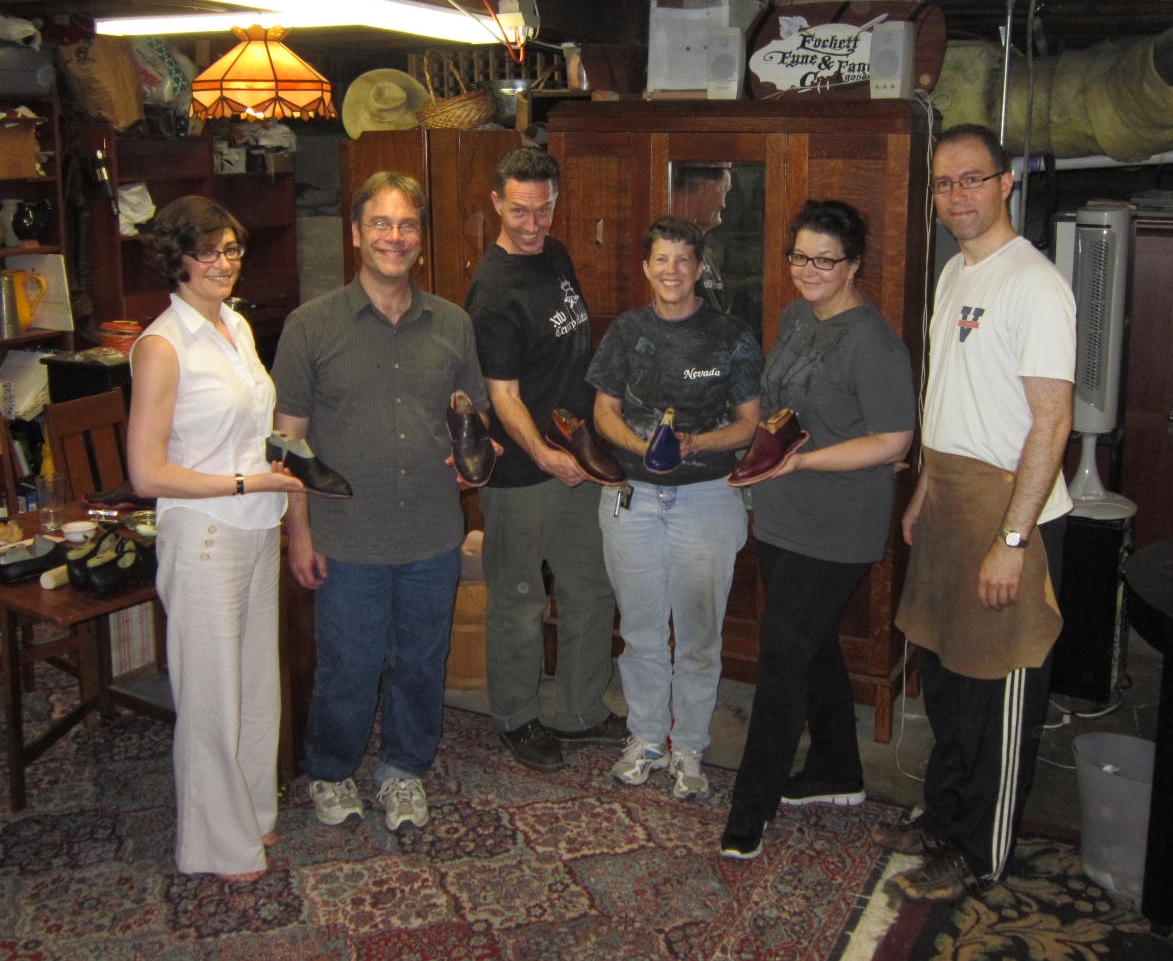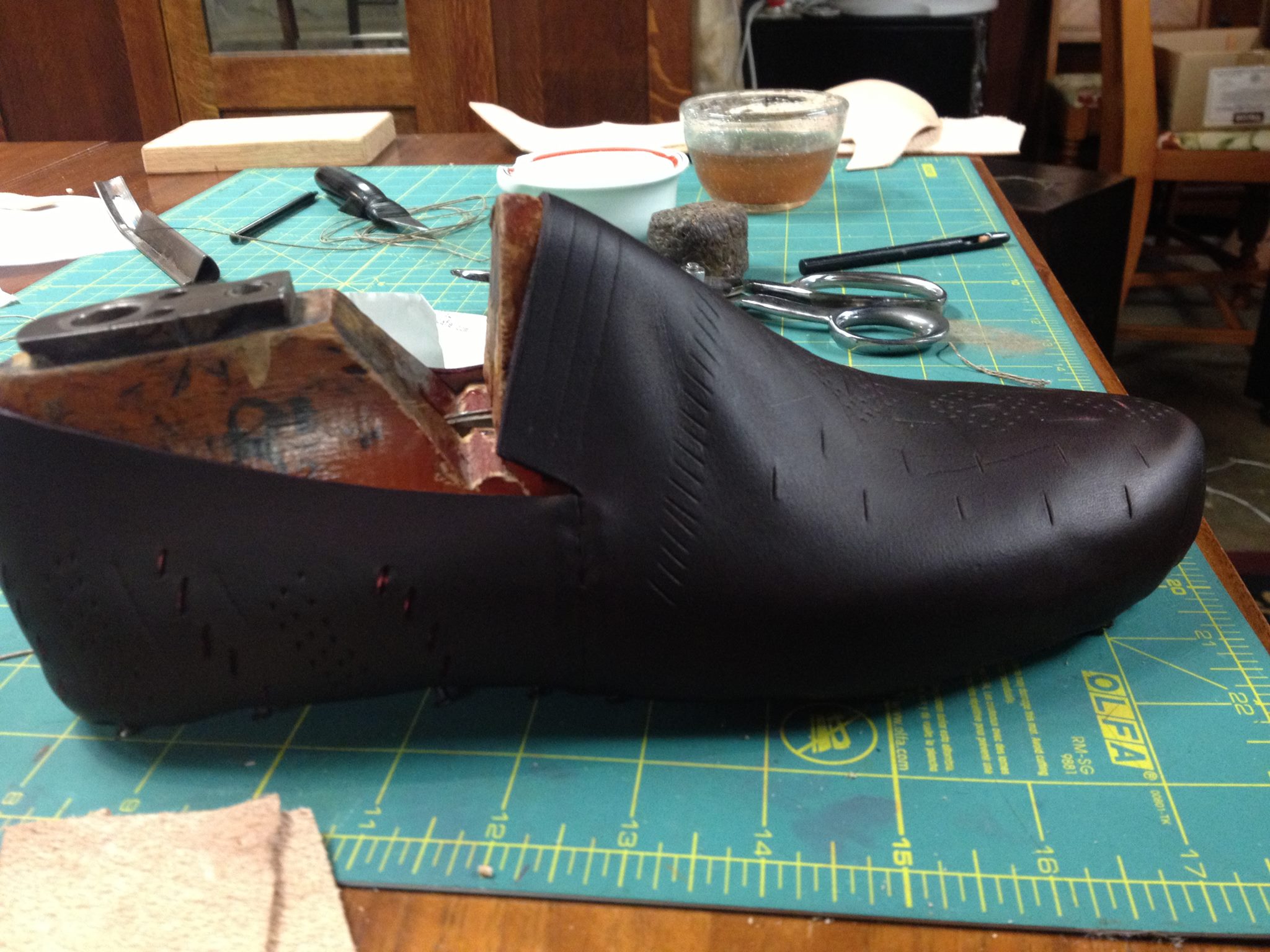In the past two weekends, I hosted a three-day Renaissance Shoemaking workshop. I had both beginners who had never held an awl before as well as some who had made a few pairs of shoes already. In general, I think the class was an excellent success. The students all learned a great deal, and I even came away with some improvements in my technique. Here is a shot of everyone with one of their finished shoes.
We started the workshop off by choosing appropriate lasts and modifying them to fit each student’s feet.
In two cases, we had to add a bit of bondo to the toe to give it the appropriate shape, rather than adding bits of leather. I had made all of the stitching cords for the class – this really seems to make the most sense, because making stitching cords are much more of an art than a science, and I can imagine a whole workshop where we just practice making stitching cords. Even so, just getting the lasts sorted took about half of the day, time that I had expected we would be cutting out patterns and closing. We were able to close and last two pairs late on the first day, but the other two students had to come back later in the week to finish the closing and lasting.
By the official second day, we were all back up to the same level for inseaming. However, inseaming also took longer than I expected, and even five hours was not enough for some students to inseam a single shoe, which was rather unexpected. I ended up helping out quite a bit in the inseaming portion, more than I was expecting to.
I had hoped that on the third day, we would sew the outsoles on with plenty of time to spare, as it only takes me about an hour and a half to outsole a single shoe. But, we ran almost all the way to dinner (and then some) before we were able to get everyone’s shoes outsoled and trimmed.
So, if I was to do the class again, I think that I would have to schedule three weekends for the workshop, which, unfortunately, would make it much more time intensive and difficult to schedule. On the plus side, if I was to offer tools, lasts, and some basic materials, people might be willing to spend more on the workshop since they would be coming away with the tools and techniques to make their own shoes. For Renaissance welted shoes, I estimate that the number of six-hour days we would need would be as follows:
Day 1: Adjusting lasts, cutting insole and sock. Decide on type of shoe and ornamentation, and generate upper pattern.
Day 2: Cut upper, ornament, dye, close, and last.
Day 3: Inseaming Shoe 1, possibly starting on Shoe 2
Day 4: Inseaming Shoe 2
Day 5: Outsole Shoe 1, Heel Lift, and Trim, possibly starting on Shoe 2
Day 6: Outsole Shoe 2, Heel Lift, and Trim
6 days, however, is quite an investment. Still, if there is availability on three different weekends (quite a commitment), then it might be worthwhile.




I don’t think that’s an unreasonable conclusion; if an artisan runs a similar course on corsetmaking, for example, or shirtmaking, there’s a similar need to run it over an extended period if students are to come away with a completed, or almost-completed, garment.
The alternatives are (a) to teach the techniques and come away with some kind of sampler or samplers, although I’m not sure that this option would lend itself to shoemaking as well as it does to shirtmaking unless it was, say, a child’s size shoe (for your amusement, I will email you a photo of a beautiful shirtmaking sampler that I can’t share online), or
(b) If people are to come away with the tools they need (which, let’s face it, will not be simple to source and select effectively for a beginner – there’s a service in itself), then perhaps the weekends could be structured such that homework assignments might get them through the slow or repetitive tasks more effectively. Could some of the prep work also happen remotely, before the in-person class begins?
It’s certainly a dilemma that extends beyond the work of the cordwainer, and I look forward to seeing how you choose to move forward.
Interesting ideas – certainly, I think that having a finished pair at the end would be somewhat necessary, as giving someone the skill set is only so useful, but you bring up a very good point.
In many ways, offering a set of workshops which would include materials, lasts, bristles, awls, etc. would be a good option (and there are some historical makers who do this), but not many people would be able to cover the several hundreds of dollars needed to cover such an investment. Only those that were really into shoemaking would be interested, and I think that (unfortunately) those types are few and far between.